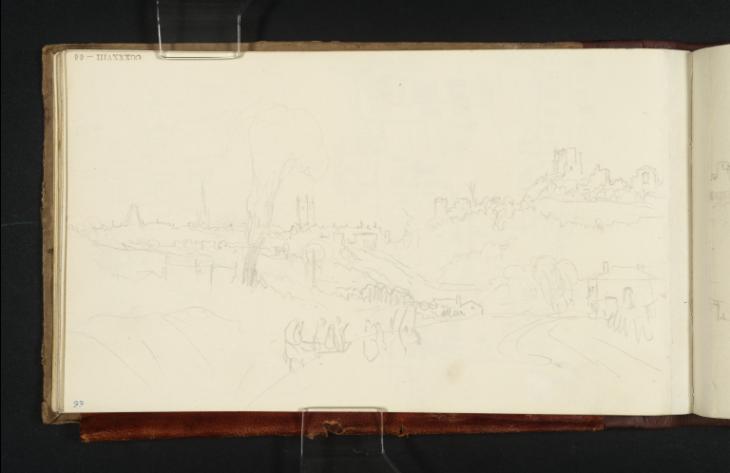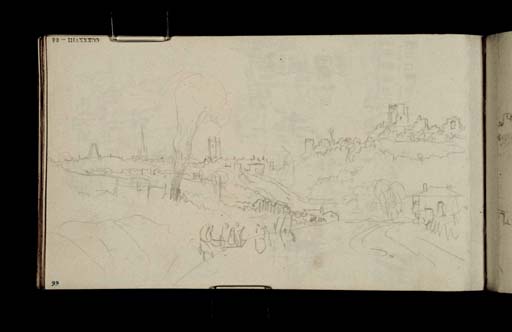J.M.W. Turner
>
1830-35 Annual tourist
>
Midlands 1830
>
Kenilworth Sketchbook
>
Artwork
Joseph Mallord William Turner Dudley: The Castle, St Edmund's Church and St Thomas's Church from the East 1830
Image 1 of 2
Joseph Mallord William Turner,
Dudley: The Castle, St Edmund's Church and St Thomas's Church from the East
1830
Joseph Mallord William Turner 1775–1851
Folio 68 Recto:
Dudley: The Castle, St Edmund’s Church and St Thomas’s Church from the East 1830
D22103
Turner Bequest CCXXXVIII 66
Turner Bequest CCXXXVIII 66
Pencil on white wove paper, 120 x 203 mm
Inscribed by John Ruskin in blue ink ‘66’ bottom left, upside down
Stamped in black ‘CCXXXVIII – 66’ top left, upside down
Inscribed by John Ruskin in blue ink ‘66’ bottom left, upside down
Stamped in black ‘CCXXXVIII – 66’ top left, upside down
Accepted by the nation as part of the Turner Bequest 1856
References
1909
A.J. Finberg, A Complete Inventory of the Drawings of the Turner Bequest, London 1909, vol.II, p.732, CCXXXVIII 66, as ‘Do. [i.e. ditto: ‘Ruined castle on hill’], with town in distance’.
1979
Eric Shanes, Turner’s Picturesque Views in England and Wales 1825–1838, London 1979, p.156, as a Dudley subject.
1988
William S. Rodner, ‘Turner’s “Dudley”: Continuity, Change and Adaptability in the Industrial Black Country’, Turner Studies, vol.8, no.1, Summer 1988, pp.35–6, ill.4.
1990
Frank Milner, J.M.W. Turner: Paintings in Merseyside Collections: Walker Art Gallery; Sudley Art Gallery; Williamson Art Gallery; Lady Lever Art Gallery; Liverpool University Art Gallery, Liverpool 1990, p.53 under no.26, reproduced as ‘Study for “Dudley” taken from the old Birmingham road’, pp.54–5.
1992
Anne Lyles, Turner: The Fifth Decade: Watercolours 1830–1840, exhibition catalogue, Tate Gallery, London 1992, p.53 under no.16.
1997
William S. Rodner, J.M.W. Turner: Romantic Painter of the Industrial Revolution, Berkeley and London 1997, p.113, fig.44.
Inverted relative to the sketchbook’s foliation, this sketch continues half way across folio 67 verso opposite (D22102; Turner Bequest CCXXXVIII 65a). With the ruins of Dudley Castle on the skyline to the right, and the tower and spire of St Edmund’s and St Thomas’s Church to the left, this view from the east apparently shows the old Birmingham road in the foreground,1 although later developments hamper an equivalent view today.
Of all his many sketches of Dudley (see under folio 23 recto; D22016), when Turner came to compose his watercolour Dudley, Worcestershire of about 1832 (Lady Lever Art Gallery, Port Sunlight),2 engraved in 1835 for the Picturesque Views in England and Wales (Tate impressions: T05097, T06113, T06114), he seems to have used the background from this double-page drawing.3 He replaced the receding roadway with a canal flanked by industrial buildings, observed elsewhere in the area, their smoke and flames contrasting dramatically with the night sky over the castle and churches.
Dudley and the England and Wales watercolour are discussed further under D22016.
Matthew Imms
August 2013
Andrew Wilton, J.M.W. Turner: His Life and Work, Fribourg 1979, p.400 no.858, pl.195; Wilton mentions the present sketchbook but not specific folios; see also Martin Butlin, Andrew Wilton and John Gage, Turner 1775–1851, exhibition catalogue, Royal Academy, London 1974, p.122 under no.426, which also discusses views of Dudley in this sketchbook without specific references.
How to cite
Matthew Imms, ‘Dudley: The Castle, St Edmund’s Church and St Thomas’s Church from the East 1830 by Joseph Mallord William Turner’, catalogue entry, August 2013, in David Blayney Brown (ed.), J.M.W. Turner: Sketchbooks, Drawings and Watercolours, Tate Research Publication, September 2014, https://www


